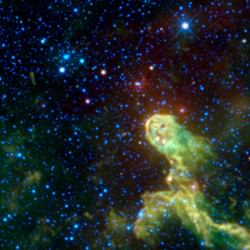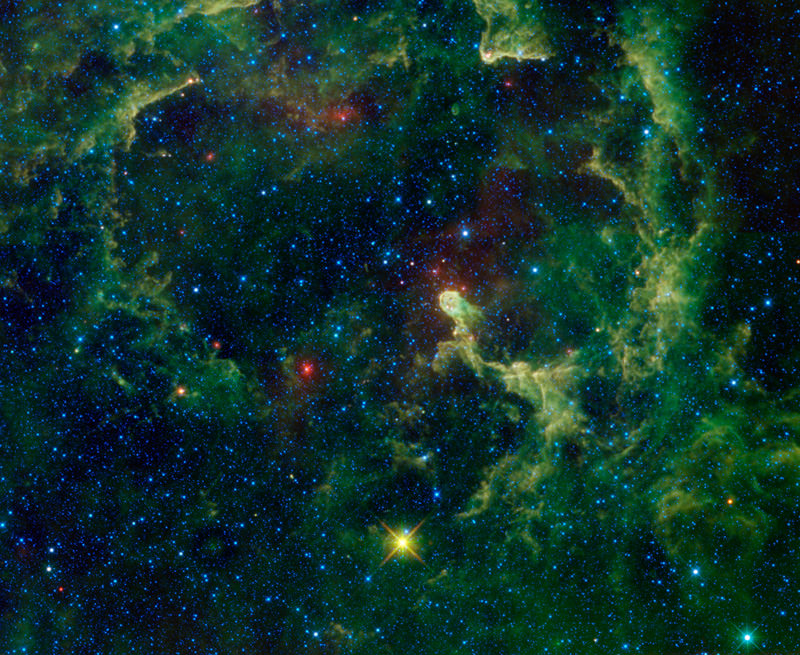[/caption]
The stellar wind, that is! This beautiful image, taken by NASA’s Wide-Field Infrared Explorer (WISE) shows a vast ring of interstellar dust and gas being forced outwards by the wind and radiation from a massive star.
The star, HR8281, is located in the center of the image, the topmost star in a small triangular formation of blue stars to the upper left of the tip of a bright elongated structure – the end of the “elephant trunk” that gives the nebula its name. The star may not look like much, but HR8281’s powerful stellar wind is what’s sculpting the huge cloud of dust into the beautiful shapes seen in this infrared image.
Located 2,450 light-years from Earth, the Elephant’s Trunk Nebula spans 100 light-years. The “trunk” itself is about 30 light-years long. (That’s about, oh… 180 trillion miles!)
Structures like this are common in nebulae. They are formed when the stellar wind – the outpouring of ultraviolet radiation and charged particles that are constantly streaming off stars – blows away the gas and dust near a star, leaving only the densest areas. It’s basically erosion on a massive interstellar scale.

It’s not just a destructive process, though. Within those dense areas new stars can form… in fact, in the bright tip of the trunk above a small dark spot can be seen. That’s an area that’s been cleared by the creation of a new star. When a baby star “ignites” and its nuclear fusion factory turns on, its stellar wind clears away the dust and gas in the cloud it was formed from. Nebulae aren’t just pretty clouds in space… they’re stellar nurseries!
The red-colored stars in this image are other newborn stars, still wrapped in their dusty “cocoons”.
The colors used in this image represent specific wavelengths of infrared light. Blue and cyan (blue-green) represent light emitted at wavelengths of 3.4 and 4.6 microns, which is predominantly from stars. Green and red represent light from 12 and 22 microns, respectively, which is mostly emitted by dust.
Read more about this image on the WISE site here.
Image Credit: NASA/JPL-Caltech/WISE Team


Well, to me it looks like a Klingon “Bird of Prey” spaceship in the process of de-cloaking.
=^..^=
Thanks…fixed it!
These are some nice pictures by WISE, but a comparison with a visible light image of this region might help put this view into better perspective. The Elephant Trunk Nebula (IC 1396A) is an impressive, but elusive, target for visual observers. In visible light images, IC 1396A appears a a *dark* cometary nebula. At the wavelengths WISE is using here, this cold dust appears quite bright. Narrowband “Hubble palette” images of IC 1396A & vdB 142 by Johannes Schedler are quite impressive:
http://www.panther-observatory.com/gallery/deepsky/doc/VDB142_F10_mapped_30.htm
http://www.panther-observatory.com/gallery/deepsky/doc/VDB142_F10_mapped_c80.htm
Of course, this nebula is embedded in a much larger star-forming region, IC 1396 (this image, done w-Hubble palette, by Russell Croman): http://www.rc-astro.com/photo/id1031.html
Very interesting to flip back-and-forth between the WISE IR images and the visible light images I’ve linked. Enjoy!
Great images Jon. Stunning.
Ditto!
Very impressive!
what can i say besides… WOW!